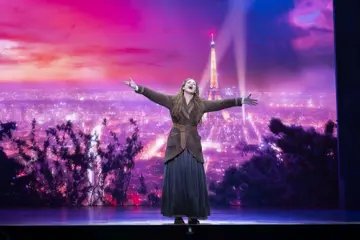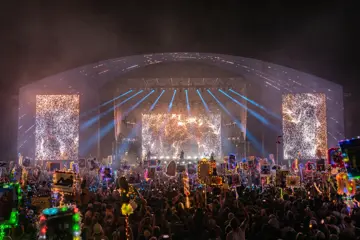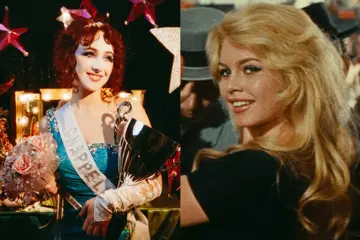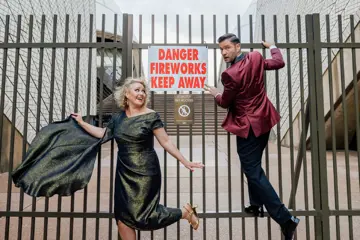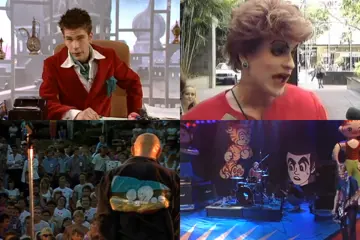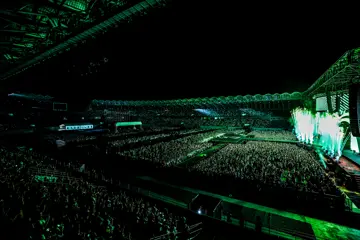K-Pop is going through another boom – and the phenomenal success of Netflix movie KPop Demon Hunters is the latest saga as it taps more into younger fans.
It showed how K-Pop – colourful with vibrant fashion, choreography, theatrics, merchandise and instant sing-alongs – has also been embraced by Gen Alpha, those aged one to 12.
The August 23rd and 24th singalong cinema screenings by Hoyts in Australia – which its General Manager of Programming & Content Michelle Gater called “the ultimate fan experience” – reflected that.
US figures, which could well reflect Australia’s, show K-Pop is second favourite for pre-teens.
According to children’s social media app Zigazoo, which has 12 million users, a survey of over 4,500 Gen Alpha users, found K-Pop was the favourite genre for 25%.
Pop leads the list with 31%. Christian and country music were 17% while hip hop was at 10%.
In Australia, five waves of fans expanded from Korean visiting students in their teens to a wider demographic including a wider age group, multi racial and more sexual orientations.
The biggest growth in this country has come from SBS’ Asia Pop series and YouTube.
“YouTube is such an important tool for K-Pop,” Brett Smith, Manager of Music Programming at SBS Audio has told this writer.
“The visuals and the money that these entertainment companies put into their music videos is unbelievable.”
Don't miss a beat with our FREE daily newsletter
Smith said many K-Pop music videos could exceed the $1 million mark. “K-pop set a new worldwide quality standard for music videos many years ago and most western artists still can’t come close to this in my opinion.”
A deep-dive in promoter Live Nation Entertainment’s fan insight series Future Sound (2024) found that despite its massive teen female appeal, “35% of its Australian and New Zealand audiences are aged between 27 and 48” and listen for 15 hours a week.
The study looked at the wider Asia Pop, which included K-Pop, J-Pop and C-Pop, and the emerging Mandopop, Thai Pop and City Pop.
Australia has a live thirst for K-Pop, with a 600% increase in Asian Pop shows and a 275% surge in the number of artists between 2015 and 2024. A full 100% of those surveyed wanted to see more concerts.
K-Pop superstars such as BTS, BLACKPINK and TWICE have toured often to huge audiences in arenas. In the last two years, TWICE and Stray Kids moved up in Australia from arenas to stadiums – a significant milestone for both.
Reflecting K-Pop fans’ loyalty and big spend, 5,000 Stray Kids fans per city paid to attend VIP soundchecks, while merchandise sold out.
Streaming
Australia is not in the Top 10 when it comes to K-Pop streaming. TikTok reported 61 million streams by Australian fans in the last 12 months.
Spotify had no Aussie numbers. But it has revealed that between 2014 and 2024, global K-Pop streaming grew by 470 times and artist revenues by three times in the last five years.
During this period, growth in Southeast Asia was 128% each year, while the US was up 90%.
Last year, fans worldwide discovered Korean artists’ music on Spotify over 2 billion times. The year before it was streamed for over 9.7 million hours on the platform.
Most listeners were from the United States, Indonesia, Brazil, the Philippines and Mexico.
JungJoo Park, Head of Music at Spotify Korea said, “Spotify offers immersive experiences to connect artists and fans, beyond just streaming.
“Offline events held with groups like SEVENTEEN and ENHYPEN have led to noticeable increases in fandom growth and streaming numbers.”
She also noted Korean users tend to engage with music more actively and independently. “They create more playlists than any other country. They curate and share playlists on their own, using the service in a very proactive way.”
It will be interesting to see how the phenomenal success of KPop Demon Hunters will change the audience make-up for K-Pop in Australia and overseas.
Last week it became the all-time most-watched Netflix original film worldwide with 236 million total views beating 230.9 million for Red Notice.
The songs on the soundtrack are designed to sing along and are irresistible. So is the story line of K-pop superstars Rumi, Mira and Zoey (aka HUNTR/X) using their secret identities to protect fans from demon hunters and come up against a rival boy band of demons in disguise, Saja Boys.
In the US, the singalong weekend grossed between $18 million to $20 million. The singalong is now streaming on Netflix.
No figures are available for the movie’s impact on K-Pop streaming in Australia.
But streams nearly doubled in under two months in the US, where the soundtrack album topped the Billboard chart. It also set a new record, when four tracks from a soundtrack album simultaneously entered the top 10 for the first time in Billboard history.
According to US market research firm Luminate, overall K-pop streaming in the US jumped from 150 million plays on June 20 – the day the film was released – to 300 million the week after.
Luminate called it “one of the most dramatic growth surges for K-pop in recent years.”
It’s stayed steady in the ten weeks since. The movie’s audience is younger than the average Netflix hit film. 31% of its audience is aged under 18, and 50% under 34.
HUNTR/X have attracted 13.9 million listeners per month on Spotify. Saja Boys have 11.4 million monthly listeners on the platform.
The soundtrack has been streamed 3 billion times.
In Australia, this week (from September 1) it held at the No. 1 spot for a tenth week. It is the biggest chart-topper from an animated movie since the ARIA charts started in 1983.
Trolls spent three weeks on top in 2017, Frozen two weeks in 2014, and Shrek 2 and Encanto one week in 2004 and 2022 respectively.
Also this week, the singles continued to storm the ARIA chart. Golden remained at No. 1, Soda Pop at No. 4, Your Idol at No. 5, How It's Done at No. 7, What It Sounds Like at No. 8 and Free at No. 10.
Also Stray Kids came in at No. 4 with Karma.
The film’s soundtrack also features the original song Takedown (TWICE version), performed by Jeongyeon, Jihyo, and Chaeyoung of TWICE.
“I have been a fan of these incredible artists and their work for many years,” said Maggie Kang, who came up with the film’s plot, co-wrote the script and co-directed.
“So it’s a dream come true to have original songs written and produced for our film by legendary talent such as THEBLACKLABEL.
“I also couldn’t be more thrilled about our collaboration with Jeongyeon, Jihyo, and Chaeyoung of TWICE. It really legitimizes our film and songs in the K-pop world. It’s proof that we achieved what we set out to do, which is make a real K-pop group.”
TWICE “found it so exciting to be a part of KPop Demon Hunters and connect with these brave characters through music. It felt extra special because it brings together K-pop and animation — two very creative worlds!”
The film even turned the fortunes of its voices. Former member of K-pop boyband U-KISS, Kevin Woo, who voiced Mystery Saja, saw his Spotify followers leap from 10,000 to 30 million.
In recent years, K-Pop factories have been creating virtual artists as Naevis, and virtual girl group SYNDI8 and MAVE. KPop Demon Hunters has in 2025 not only rewritten the future of virtual pop, but speculation that a sequel is already in the works will see its impact continue for years.
K-Pop’s greater mainstream profile sends a message to Australian brands that the music and visuals is a way to reach that audience.
Feedback from the Live Nation survey was that 77% of Australian K-Pop fans feel “brands aren’t doing enough to support the Asian community” and 97% stated, “I would like to see more brands partner with Asia Pop artists in Australia and New Zealand.”
94% of fans believed fashion brands are the best partner for Asia Pop, followed by entertainment by 88%, beauty for 86%, and travel and tourism for 66%.
Merchandising Boom
The overwhelming fan interaction of KPop Demon Hunters also extended to merchandising.
Already taking pre-orders for December 2025 to January 2026, US pop culture merch company Funko Pop! which has a presence in Australian stores, has items based around the characters.
The collection includes Rumi, Mira, Zoey, Jinu and a glow-in-the-dark Derpy Tiger with Sussie Bird.
Fans can also create a Demon Hunters version of themselves with a custom Pop! Yourself line, choosing hairstyle, facial features and skin tone.
Netflix’s online store also stocks polar bear sweatshirt, pyjamas, tropical bomber jackets, plushes, stickers, posters, blankets, phone cases and more featuring individual characters.
Other retailers have vinyl, T-shirts, hoodies, jewellery and light sticks inspired by the movie.
Korean noodle company Nongshim which in recent years, has been focussed on making its popular Shin Ramyun brand a global staple with different flavours. Earlier this year, it introduced the food item in Australia via Woolworths stores.
In 2024 Nongshim had total sales of 3.44 trillion won (AUD $3.97 billion). Exports to over 100 countries accounted for 40%. This year it has cashed in on selling food items from the movie as well as a bounce in all Korean food.
Kim Jun-tae, a sales director at Nongshim, told one Korean media outlet its main customers were students and young adults, adventurous, and already K-Pop fans.
“Most of our marketing and social media campaigns are aimed directly at them. We’re still in the early stages of building a premium, trendy image for Korean ramyun among young consumers globally. The future looks promising.”


